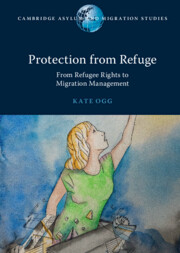Book contents
- Protection from Refuge
- Cambridge Asylum and Migration Studies
- Protection from Refuge
- Copyright page
- Dedication
- Contents
- Preface
- Acknowledgements
- Abbreviations
- 1 Journeys in Search of Refuge
- 2 Refuge as a Concept and a Place
- 3 Using Human and Refugee Rights to Resist Encampment
- 4 Using Human Rights Law to Travel in Search of Refuge in Europe
- 5 Direct Challenges to Regional Containment Instruments
- 6 Seeking Refuge as a Palestinian Refugee
- 7 Resisting the Prospect of Refuge in an IDP Camp
- 8 Elusive Refuge
- Index
4 - Using Human Rights Law to Travel in Search of Refuge in Europe
Published online by Cambridge University Press: 17 March 2022
- Protection from Refuge
- Cambridge Asylum and Migration Studies
- Protection from Refuge
- Copyright page
- Dedication
- Contents
- Preface
- Acknowledgements
- Abbreviations
- 1 Journeys in Search of Refuge
- 2 Refuge as a Concept and a Place
- 3 Using Human and Refugee Rights to Resist Encampment
- 4 Using Human Rights Law to Travel in Search of Refuge in Europe
- 5 Direct Challenges to Regional Containment Instruments
- 6 Seeking Refuge as a Palestinian Refugee
- 7 Resisting the Prospect of Refuge in an IDP Camp
- 8 Elusive Refuge
- Index
Summary
Chapter 4 focuses on protection from refuge claims made in the European context. It examines cases in which refugees use human rights law to challenge a European externalisation practice or request or resist a transfer made pursuant to the European Union’s Dublin System. Such claims are made before the European Court of Human Rights or domestic adjudicative decision-making bodies under the European Convention of Human Rights. They are also made before United Nations treaty bodies using international human rights law. I argue that in initial and early European protection from refuge claims, decision-makers identified common aspects of refugeehood and used human rights to engage with the functions and nature of refuge. There was an understanding that refuge is a remedy that must address present, future and past vicissitudes of displacement but decision-makers now search for the ‘good’ or ‘peculiarly vulnerable’ refugee. This has resulted in decision-makers approaching refuge as a scarce commodity and one stripped down to the barest minimum of protections. In searching for the exceptional refugee, most decision-makers approach questions of gender, age and disability in a nominal manner.
Keywords
- Type
- Chapter
- Information
- Protection from RefugeFrom Refugee Rights to Migration Management, pp. 79 - 111Publisher: Cambridge University PressPrint publication year: 2022

